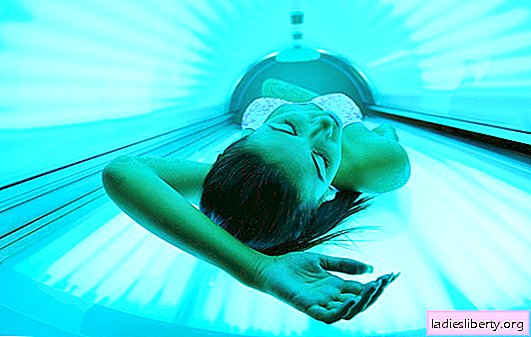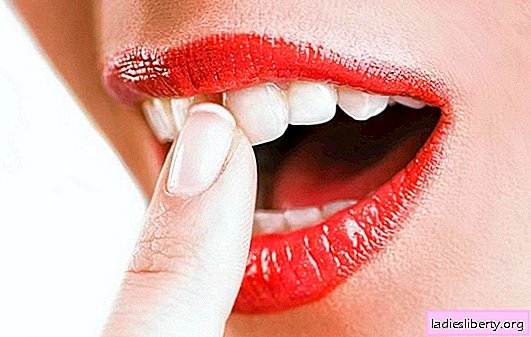
What could be more attractive than a golden skin tone?
The beach season is still so far away, and you want a beautiful velvet body right now.
It’s easy to become the owner of such a tan.
The fair sex is enough to visit the solarium.
The word solarium itself consists of two words: Greek "air" and Latin "sunny". But is artificial tanning so safe?
Is it easy to be beautiful without harming one's own health?
In this article we will understand what the harm and benefits of a tanning bed are.
Solarium - what is it?
Since the end of the last century, tanning has become fashionable and has become the personification of youth, beauty, affluence and idleness. Currently, every beauty salon, fitness center, spa center and bath complex are equipped with solariums.
Tanning salons are specially equipped booths that produce ultraviolet rays of a certain dosage. Artificial radiation is almost identical to taking natural sun baths.
Tanning salons are divided into 2 types:
• Horizontal (recumbent tanning)
• Vertical (tan is taken standing).
Horizontal tanning salons are the most popular type, but one of the main disadvantages is that the tan can turn out uneven in places where the skin is in contact with the surface of the bed (thighs and sides). But since lamps of weaker power are used there, then staying 15-20 minutes you can completely relax and rest without fear of getting a burn. The cost of horizontal tanning treatments is slightly lower.
In a vertical tanning bed the tan lies completely flat. Lamps of greater power limit their stay in such a solarium to 10-12 minutes. This type of booths is considered more hygienic, as the body does not experience direct contact with the coating. In the vertical tanning bed you can also dance to cheerful music. The ideal option is to alternate visits to these two types of tanning salons..
Solarium: what are the benefits for the body?
The benefits of ultraviolet rays have been known since ancient times. Heliotherapy, the so-called sun therapy, was actively used by the Greeks and Romans, equipping special rooms for sunbathing - solariums.
The main plus is the quick receipt of the desired tan. What is a tan? This is a darkening of the skin that occurs as a result of exposure to ultraviolet radiation on skin cells, as a result of which they produce a special pigment - melanin. Tanning in the tanning bed is even and smooth, no trace of a swimsuit. Thousands of women visit the solarium regularly every season, arguing that tanned skin looks more toned and attractive, and the dress on bronze skin looks much more spectacular. Taking a tan on the beach, we cannot regulate it and it is extremely difficult to deny ourselves the extra hour to lie in the sun. A solarium is the same sun as in the sky, only filtered and broken down into doses.
Solarium - a source of well-being, which favorably affects the metabolism. He perfectly fights the accumulated fatigue, and, leaving the booth, you feel a surge of strength and a second wind.
The skin, performing the protective function of our body, itself needs protection, therefore, a tanning bed is an excellent preparation of the epidermis layers for subsequent rest at sea. This significantly reduces the risk of burns.
Tanning in a tanning bed is much safer than being in the open sun, as the lamps do not emit ultraviolet radiation. It has been proven that exposure to the sun can lead to skin cancer.
Irradiation contributes to the accumulation of vitamin D in the body, a deficiency of which can lead to a number of unpleasant diseases:
• colds
• diseases of the skin and joints
• rickets
• psoriasis
• neurodermatitis.
Studies by scientists in America have shown that obtaining calcium through radiation is 70% more effective than calcium in capsules. Many women who regularly visit the tanning bed have forgotten about tooth and muscle pain forever.
Doctors recommend a visit to the solarium to people with weakened immunity, the body will be ready to meet and attack any virus and bacteria.
Ultraviolet has a healing effect on the skin, the skin is dried, and you can forget about acne and other rashes.
A tan will improve your mood and increase your susceptibility to stress, as it contributes to the production of endorphin - the hormone of happiness and pleasure. Scientists have conducted a series of studies proving that poor mood, apathy and lethargy are not only a lack of vitamins, but also a lack of sun.
In the winter months, a tanning bed will help to cope with attacks of causeless sadness, depression and fatigue. Of course, you can set aside daily time for walking, playing sports, but, given our busy schedule, we choose to visit the solarium several times a month.
Solarium: what is the harm to health?
The main argument against: tanning bed - oncology catalystprimarily skin cancer. More than a third of the population suffering from melanomas and other forms of oncology manifestations are accounted for by people under 40 years of age, and before that only elderly people suffered from this. Swedish scientists have proven that people visiting the solarium more than 10 times a year are exposed to skin cancer 7 times more!
The tanning industry is almost unregulated. Lamps can contain much more radiation than sunlight. One visit to the tanning booth can be equated to a whole day on the beach under the scorching sun!
After visiting the tanning bed, you can notice that the hair has become dry and brittle, and the skin has dried and covered with spots and freckles.
Solarium causes skin aging, which is difficult to argue, since this fact is scientifically proven - the skin loses its elasticity and smoothness, small wrinkles and cracks begin to appear.
Frequent visits to the tanning bed can cause malfunctions of the thyroid gland and mammary glands.
Ultraviolet rays can cause visual impairment, up to the appearance of cataracts - fogging of the lens of the eye and melanoma of the retina.
Before visiting a solarium, check if you have contraindications to it:
• the presence of cardiovascular disease, bronchial asthma, tuberculosis, mastopathy, diabetes
• the presence of various kinds of gynecological diseases
• recent operations
• fear of enclosed spaces
• predisposition to allergies
• very light skin
• the presence of tattoos
• recent cosmetic procedures (peeling, hair removal)
• a large number of moles and age spots
• you are a pregnant girl or a nursing mother
• menstruation period
• taking medications
• exacerbation of a chronic disease.
Frequent trips to the solarium contribute to psychological addiction called the term "tanorexia" - A constant desire to have tanned skin, regardless of the time of year. The dependence on the chocolate color of the body becomes equally the same as the need for air. It affects mainly people under 25-30 years old. Being sensitive to mood swings, girls suffer from tanorexia more often than young people. A person begins to need to receive ultraviolet rays at a psychological level, and their absence exposes him to a depressed state.
Tanning is the reaction of the body to the effects of rays. We are all individual, and everyone has different skin, therefore each of us has a special tolerance for tanning beds. When it comes to health, it is important to compare the harm and benefits of the procedures to which we expose ourselves. In order to minimize the risks of negative consequences of visiting a solarium, be sure to consult a doctor. The doctor will help you correctly approach the preparation for tanning, determine your skin type, select a schedule of solar procedures, adjusting their duration.
The benefits and harms of tanning beds for children
Legislatively children are allowed to visit the solarium, but until the age of 15 it is advisable not to let the children go there, as their skin is more susceptible and sensitive.
WHO claims that artificial irradiation can lead to skin cancer, so children under 18 years of age are strictly forbidden to visit the solarium - a possibly damaging effect on the structure of the skin and burns.
In order to prevent the tanorexia that is rapidly gaining momentum, the governments of Germany and Great Britain were forced to take extreme measures and prohibit children under 16 from visiting the tanning bed.
The United States wants to ban ultraviolet rays before the age of 18. In almost 30 countries around the world, adolescents cannot visit tanning salons without the written permission of their parents.
Parents take their children there for various reasons. Doctors often recommend solarium treatments for children with vitamin D deficiency, which ensures the growth and development of the body. But remember that you can get vitamins from products containing calcium. Often, the beloved child suffers from hormonal skin problems, and the mother finds a way to take the child to the solarium for a procedure.
When taking the child to the solarium, do not forget to make sure that he wears special glasses and a hat, and a special cream is applied to his lips. Ultraviolet rays can weaken the imperfect immune system of children and later cause cancer. Young children should reduce the procedure for sunbathing to 2-3 minutes, children from 14 years old are not recommended to exceed five minutes. Responsibility for the health of children lies entirely on the shoulders of the parents.
The question of the benefits and harms of a tanning bed is still debatable and open. Everything is good in moderation, therefore, in order to avoid undesirable consequences for your health and the health of your children, weigh the pros and cons! And remember that you should only visit the tanning bed following a certain course - 5-6 times every six months.











